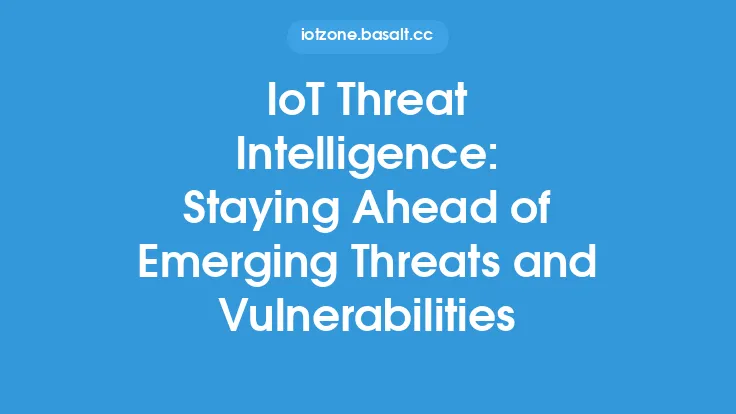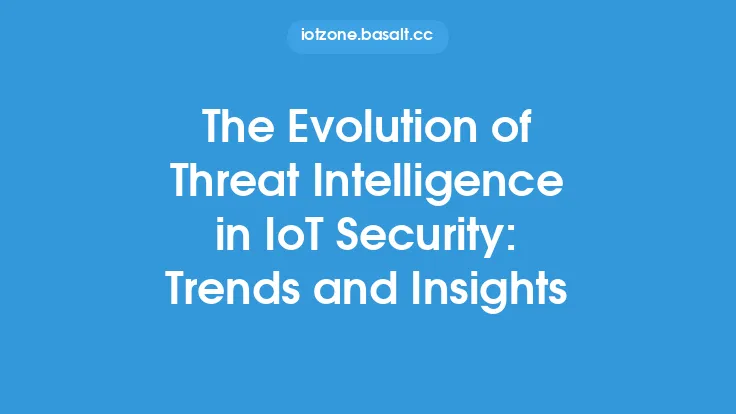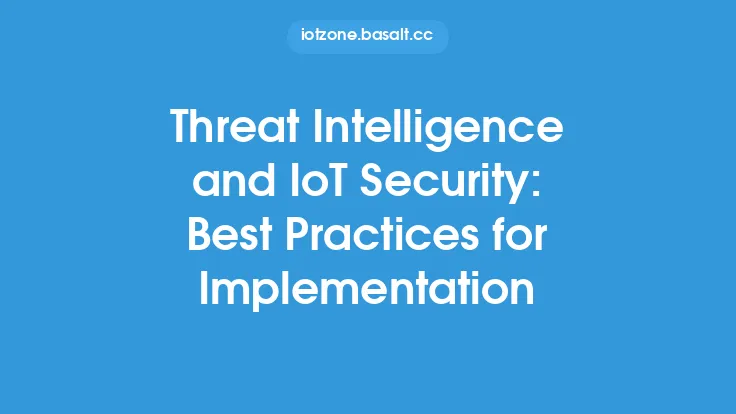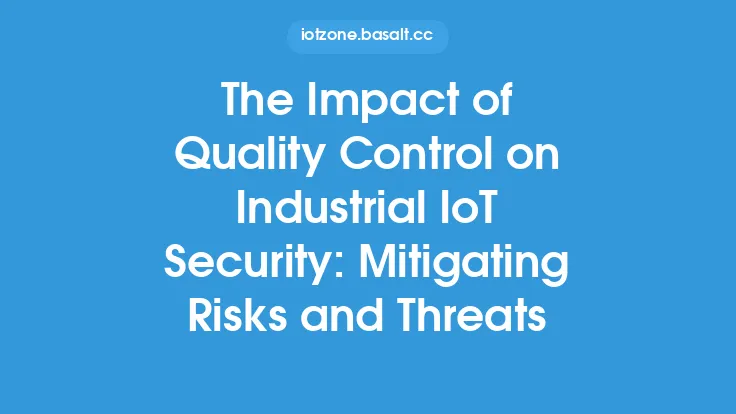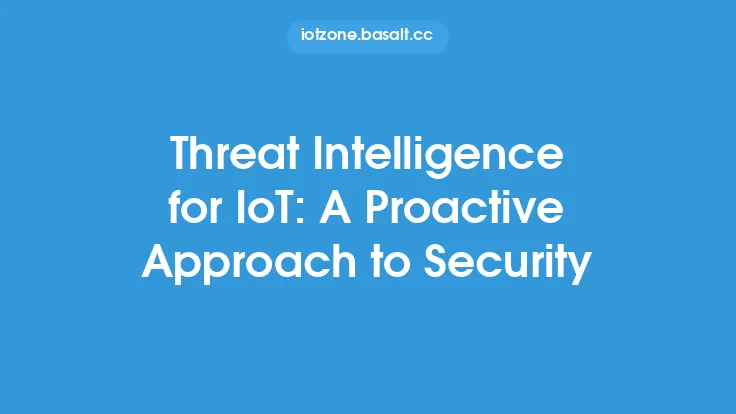The increasing number of Internet of Things (IoT) devices has created a vast attack surface, making it challenging for organizations to identify and mitigate emerging threats. IoT threat intelligence is a critical component of IoT security that involves collecting, analyzing, and disseminating information about potential or actual threats to IoT devices and systems. In this article, we will delve into the world of IoT threat intelligence, exploring its importance, key concepts, and best practices for identifying and mitigating emerging threats.
Introduction to IoT Threat Intelligence
IoT threat intelligence is a subset of threat intelligence that focuses specifically on the unique threats and vulnerabilities associated with IoT devices and systems. It involves gathering and analyzing data from various sources, including network traffic, device logs, and threat feeds, to identify potential threats and vulnerabilities. The goal of IoT threat intelligence is to provide organizations with the information they need to make informed decisions about IoT security, prioritize vulnerabilities, and allocate resources effectively.
Key Concepts in IoT Threat Intelligence
Several key concepts are essential to understanding IoT threat intelligence. These include:
- Threat feeds: Threat feeds are streams of data that provide information about known threats, such as malware, vulnerabilities, and attack patterns. Threat feeds can be used to inform IoT security decisions and prioritize vulnerabilities.
- Indicators of Compromise (IoCs): IoCs are signs that an IoT device or system has been compromised, such as unusual network traffic or suspicious device behavior. IoCs can be used to detect and respond to threats in real-time.
- Tactics, Techniques, and Procedures (TTPs): TTPs refer to the methods and techniques used by attackers to compromise IoT devices and systems. Understanding TTPs is critical to developing effective IoT security strategies.
- Vulnerability management: Vulnerability management involves identifying, prioritizing, and remediating vulnerabilities in IoT devices and systems. Effective vulnerability management is critical to preventing attacks and minimizing the risk of compromise.
Identifying Emerging Threats
Identifying emerging threats is a critical component of IoT threat intelligence. Several techniques can be used to identify emerging threats, including:
- Anomaly detection: Anomaly detection involves monitoring IoT device and system behavior to identify unusual patterns or activity. Anomaly detection can be used to detect unknown threats and identify potential vulnerabilities.
- Predictive analytics: Predictive analytics involves using machine learning and statistical models to predict the likelihood of a threat or vulnerability. Predictive analytics can be used to identify emerging threats and prioritize vulnerabilities.
- Threat hunting: Threat hunting involves proactively searching for threats and vulnerabilities in IoT devices and systems. Threat hunting can be used to identify emerging threats and detect advanced attacks.
Mitigating Emerging Threats
Mitigating emerging threats is critical to preventing attacks and minimizing the risk of compromise. Several techniques can be used to mitigate emerging threats, including:
- Patch management: Patch management involves applying patches and updates to IoT devices and systems to remediate vulnerabilities. Effective patch management is critical to preventing attacks and minimizing the risk of compromise.
- Network segmentation: Network segmentation involves dividing IoT devices and systems into separate networks or segments to limit the spread of malware and unauthorized access. Network segmentation can be used to mitigate the risk of compromise and prevent lateral movement.
- Encryption: Encryption involves protecting IoT device and system data with encryption technologies, such as SSL/TLS or IPsec. Encryption can be used to protect data in transit and prevent unauthorized access.
Best Practices for IoT Threat Intelligence
Several best practices can be used to implement effective IoT threat intelligence, including:
- Implementing a threat intelligence platform: A threat intelligence platform can be used to collect, analyze, and disseminate threat intelligence data. Implementing a threat intelligence platform can help organizations to streamline IoT security operations and improve threat detection.
- Integrating threat intelligence with IoT security systems: Integrating threat intelligence with IoT security systems, such as intrusion detection systems and security information and event management (SIEM) systems, can help organizations to automate threat detection and response.
- Providing training and awareness: Providing training and awareness to IoT security teams and stakeholders can help to improve threat detection and response. Training and awareness programs should include information about IoT threat intelligence, threat feeds, and indicators of compromise.
Technical Considerations for IoT Threat Intelligence
Several technical considerations are essential to implementing effective IoT threat intelligence, including:
- Data collection and analysis: Data collection and analysis are critical to IoT threat intelligence. Organizations should implement data collection and analysis technologies, such as log collection and analysis platforms, to collect and analyze IoT device and system data.
- Threat feed integration: Threat feed integration is critical to IoT threat intelligence. Organizations should implement threat feed integration technologies, such as threat intelligence platforms, to integrate threat feeds with IoT security systems.
- Scalability and performance: Scalability and performance are critical to IoT threat intelligence. Organizations should implement scalable and high-performance technologies, such as cloud-based threat intelligence platforms, to support large-scale IoT deployments.
Conclusion
IoT threat intelligence is a critical component of IoT security that involves collecting, analyzing, and disseminating information about potential or actual threats to IoT devices and systems. By understanding key concepts, identifying emerging threats, and mitigating risks, organizations can improve IoT security posture and prevent attacks. Implementing best practices, such as implementing a threat intelligence platform and integrating threat intelligence with IoT security systems, can help organizations to streamline IoT security operations and improve threat detection. Technical considerations, such as data collection and analysis, threat feed integration, and scalability and performance, are essential to implementing effective IoT threat intelligence. By prioritizing IoT threat intelligence, organizations can stay ahead of emerging threats and vulnerabilities, and protect their IoT devices and systems from compromise.
